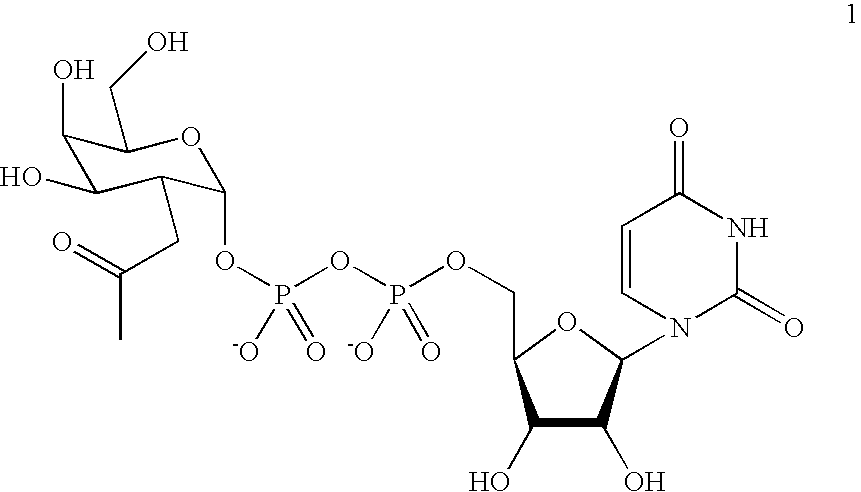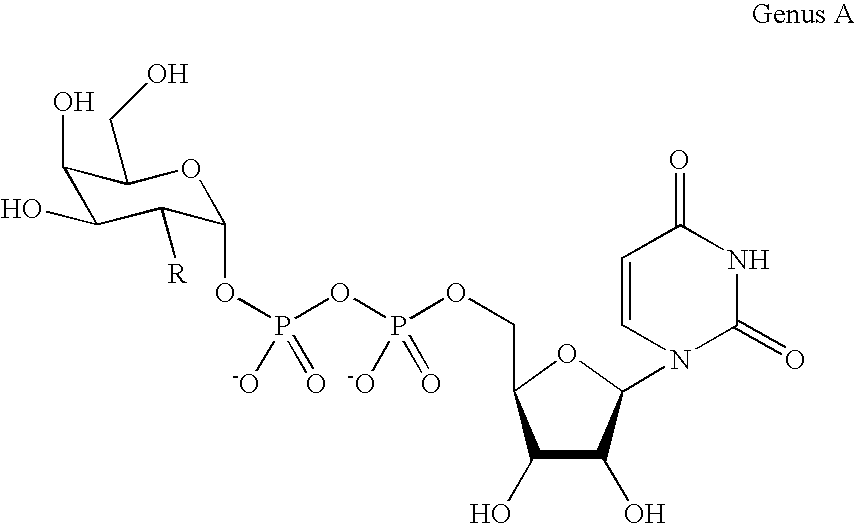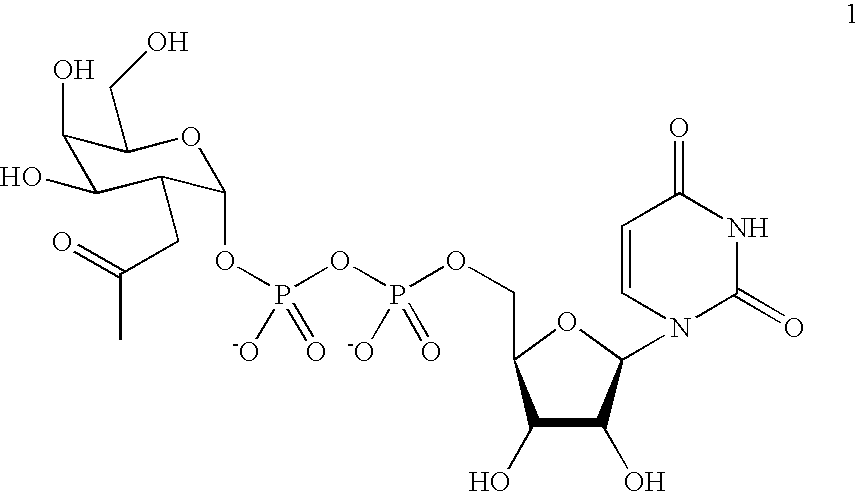Method and compositions for the detection of protein glycosylation
- Summary
- Abstract
- Description
- Claims
- Application Information
AI Technical Summary
Problems solved by technology
Method used
Image
Examples
example 1
A Chemoenzymatic Approach Toward the Rapid and Sensitive Detection of O-GlcNAc Posttranslational Modifications (95)
Design of a GlcNAc Labeling Agent
[0129] A labeling agent of uridyl diphosphate analogue 1 was designed based on previous biochemical and structural studies of GalT (FIG. 1B). The ketone chemical handle was appended at the C-2 position of the galactose ring because GalT has been shown to tolerate unnatural substrates containing minor substitutions at the C-2 position, including 2-deoxy, 2-amino, and 2-N-acetyl substituents.(6) Moreover, 2-deoxy-Gal was transferred at rates comparable to Gal, whereas 3-, 4-, and 6-deoxy-Gal were transferred at reduced rates. Analysis of the crystal structures of GalT complexed with UDP-GalNAc revealed that the C-2 N-acetyl moiety is accommodated in a shallow pocket within the active site.(7) The single Y289L mutation enlarges the binding pocket and enhances the catalytic activity toward GalNAc substrates without compromising specificit...
example 2
Parallel Identification of O-GlcNAc Modified Proteins From Cell Lysates (96)
[0171] The preferred embodiments can be used for detecting a protein for O-GlcNAc modification. The preferred embodiments circumvent the need to purify individual proteins, accommodate any cell type or tissue, and can be extended to the mapping of modification sites. The results herein identified four new O-GlcNAc glycosylated proteins of low cellular abundance (c-Fos, c-Jun, ATF-1, and CBP) and two new glycosylation sites on the protein O-GlcNAc transferase (OGT (SEQ ID NO: 49)). Using the preferred embodiments, multiple proteins could be readily interrogated in parallel by Western blotting using antibodies selective for proteins of interest.
[0172] The preferred embodiments have several notable advantages. The preferred embodiments accelerate the discovery of O-GlcNAc proteins by eliminating the need to purify individual proteins. Virtually any protein could be examined for the modification as a wide vari...
example 3
Exploring the O-GlcNAc Proteome: Direct Identification of O-GlcNAc-Modified Proteins from the Brain (97)
[0211] Protein PTMs represent an important mechanism for the regulation of cellular physiology and function. The covalent addition of chemical groups (e.g., phosphate, acetate, carbohydrate) extends the capabilities of proteins and provides a selective and temporal means of controlling protein function (51-53). Despite the importance of PTMs, their extent and significance are only beginning to be understood. O-GlcNAc glycosylation, the covalent attachment of β-N-acetylglucosamine to serine or threonine residues of proteins has been a subject of investigation (53-55). Unlike most carbohydrate modifications, 0-GlcNAc is dynamic and intracellular and, as such, shares common features with protein phosphorylation (53, 54). Nearly 80 proteins bearing the O-GlcNAc group have been identified to date, including transcription factors, cytoskeletal proteins, protein kinases, and nuclear por...
PUM
| Property | Measurement | Unit |
|---|---|---|
| Mass | aaaaa | aaaaa |
| Fluorescence | aaaaa | aaaaa |
| Chemiluminescence | aaaaa | aaaaa |
Abstract
Description
Claims
Application Information
 Login to View More
Login to View More - R&D
- Intellectual Property
- Life Sciences
- Materials
- Tech Scout
- Unparalleled Data Quality
- Higher Quality Content
- 60% Fewer Hallucinations
Browse by: Latest US Patents, China's latest patents, Technical Efficacy Thesaurus, Application Domain, Technology Topic, Popular Technical Reports.
© 2025 PatSnap. All rights reserved.Legal|Privacy policy|Modern Slavery Act Transparency Statement|Sitemap|About US| Contact US: help@patsnap.com



